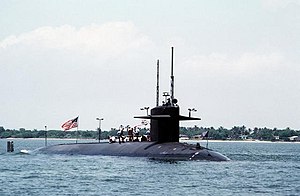Thresher class submarine

USS Greenling (SSN-614)
|
|
| Class overview | |
|---|---|
| Builders: | |
| Operators: |
|
| Preceded by: | Skipjack class |
| Succeeded by: | Sturgeon class |
| Built: | 1958–1967 |
| In commission: | 1961–1996 |
| Completed: | 14 |
| Lost: | 1 |
| Retired: | 13 |
| General characteristics | |
| Type: | Nuclear submarine |
| Displacement: |
|
| Length: | 278 ft 5 in (84.86 m) |
| Beam: | 31 ft 7 in (9.63 m) |
| Draft: | 25 ft 2 in (7.67 m) |
| Propulsion: | |
| Speed: |
|
| Range: | Unlimited, except by food supplies |
| Test depth: | 1,300 ft (400 m) |
| Complement: | 112 |
| Sensors and processing systems: |
|
| Electronic warfare & decoys: |
ESM |
| Armament: |
|
The Permit-class submarine, (known as the Thresher class until the lead boat USS Thresher was lost), was a class of nuclear-powered fast attack submarines (hull classification symbol SSN) in service with the United States Navy from the early 1960s until 1996. They were a significant improvement on the Skipjack class, with greatly improved sonar, diving depth, and silencing. They were the forerunners of all subsequent US Navy SSN designs. They served in the 1960s through middle 1980s, until retired due to age. They were followed by the Sturgeon and Los Angeles classes.
The Thresher class resulted from a study commissioned in 1956 by Chief of Naval Operations (CNO) Admiral Arleigh Burke. In "Project Nobska", the Committee on Undersea Warfare of the United States National Academy of Sciences, collaborating with numerous other agencies, considered the lessons of submarine warfare and anti-submarine warfare learned from various prototypes and experimental platforms.
The new class kept the proven S5W reactor plant from the immediately preceding Skipjacks, but were a radical change in many other ways. The Threshers had the large bow-mounted sonar sphere and angled, amidships torpedo tubes used in the concurrently-built Tullibee. This placed the sonar sphere in the optimum position for detection of targets at long range. Tullibee was an alternate design optimized for anti-submarine warfare, much smaller and slower than the Threshers and with a quiet turbo-electric propulsion system. Although they used the same HY-80 steel (yield strength 80,000 psi (550 MPa)) as the Skipjacks, the Threshers' pressure hulls were made using an improved design that extended test depth to 1,300 ft (400 m). The engineering spaces were also redesigned, with the turbines supported on "rafts" that were suspended from the hull on isolation mounts for acoustic quieting. Drag was reduced, with external fittings kept to a minimum and the sail greatly reduced in size.
...
Wikipedia
